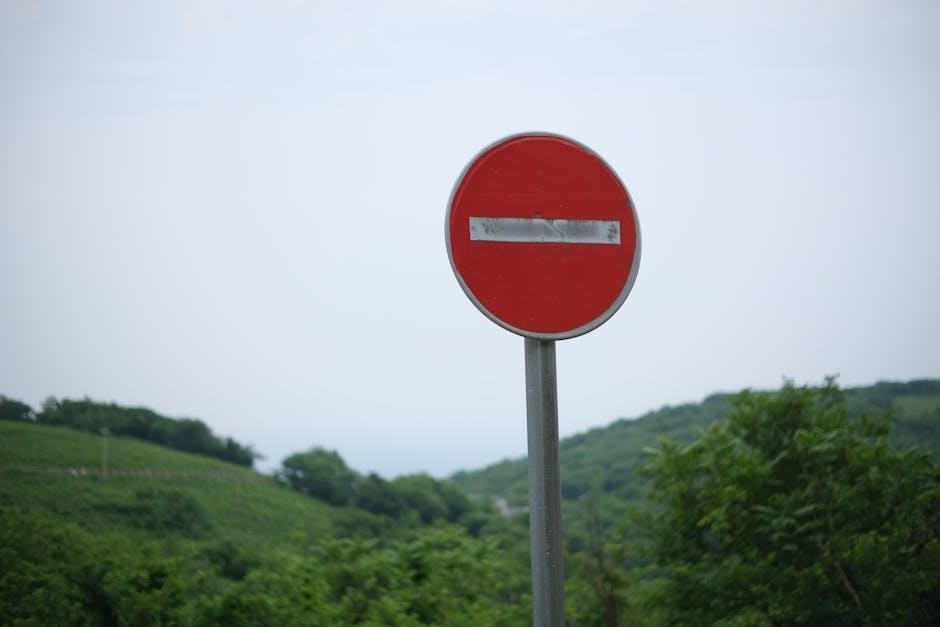Ecodefense: A Field Guide to Monkeywrenching is a controversial manual edited by Dave Foreman, offering radical strategies for environmental activism. It advocates direct action to protect ecosystems, blending sabotage techniques with philosophical justifications, inspiring both admiration and criticism within the environmental movement.
Definition and Purpose of Ecodefense
Ecodefense is a manual advocating non-violent, direct action to protect the environment through sabotage, known as “monkeywrenching.” It provides practical techniques and philosophical justification for disrupting activities harming ecosystems. The book serves as a guide for activists seeking to challenge industrial practices and government policies. Its purpose is to empower individuals to take radical steps in environmental defense, blending protest with activism to inspire change and protect wilderness areas from destruction.
The Role of Dave Foreman and Edward Abbey
Dave Foreman, a key figure in the Earth First! movement, edited Ecodefense, providing strategic guidance for environmental activism. Edward Abbey, renowned author and philosopher, contributed the foreword, infusing the book with his radical environmental ethos. Abbey’s influence inspired the manual’s tone and rationale, while Foreman’s leadership shaped its practical applications. Together, they championed direct action as a necessary response to environmental destruction, blending literary passion with activist pragmatism to fuel the monkeywrenching movement.

History and Background of the Earth First! Movement
The Earth First! Movement emerged in the 1980s, advocating radical environmentalism through direct action and sabotage, influencing the creation of Ecodefense as a tactical guide.
The Origins of Earth First! and Its Philosophy
Earth First! emerged in the 1980s, founded by Dave Foreman and inspired by Edward Abbey’s radical environmentalism. It emphasized direct action, sabotage, and biocentrism, rejecting mainstream conservation. The movement sought to halt industrial exploitation of wilderness, advocating for ecosystem preservation through militant tactics. Its philosophy, rooted in deep ecology, prioritized nature over human interests, inspiring the creation of Ecodefense as a guide for environmental activists, blending practical strategies with ideological fervor to challenge environmental destruction.
The Publication and Evolution of the Field Guide
Ecodefense: A Field Guide to Monkeywrenching was first published in 1985, edited by Dave Foreman, with subsequent editions in 1987 and 1993. The guide detailed sabotage techniques to disrupt environmental destruction, from tree spiking to road demolition. It evolved to include updated strategies and legal warnings, reflecting growing scrutiny. Despite its controversial nature, the book became a staple of radical environmentalism, inspiring both activism and criticism while influencing the Earth First! movement’s direct-action philosophy, blending practical advice with a call to defend nature at all costs.

Key Concepts and Techniques in Monkeywrenching
Monkeywrenching involves direct action tactics like tree spiking, road demolition, and sabotage to disrupt environmental destruction. These techniques aim to halt industrial activities harming ecosystems, emphasizing non-violent yet effective resistance to protect nature and inspire systemic change within the Earth First! movement.
Philosophy Behind Monkeywrenching
The philosophy of monkeywrenching centers on radical environmentalism, advocating direct action to protect ecosystems. It rejects mainstream conservation strategies, embracing sabotage as a moral response to ecological destruction. Inspired by Edward Abbey’s ideals, it promotes a deep connection with nature and resistance to industrial exploitation. Monkeywrenching seeks to disrupt systems harming the environment, emphasizing non-violent yet confrontational methods; It challenges corporate and governmental practices, fostering a movement that values wilderness preservation over economic gain, inspiring both controversy and dedicated activism within the environmental community.
Practical Techniques for Environmental Sabotage
Monkeywrenching outlines various tactics to disrupt environmental destruction, such as disabling logging equipment, spiking trees, and sabotaging infrastructure. It emphasizes non-violent yet effective methods to halt industrial activities. Techniques include damaging machinery, obstructing roads, and targeting vulnerable points in production chains. The guide stresses careful planning, caution, and avoiding detection to minimize risks. These actions are framed as necessary to protect ecosystems, blending practical advice with a call to radical environmental defense, inspiring both criticism and admiration for its bold approach to conservation.

Legal and Ethical Considerations
Ecodefense details illegal tactics, raising legal concerns and ethical debates about environmental sabotage’s justification, sparking controversy over balancing law and ecological preservation.
Legal Consequences of Monkeywrenching
Monkeywrenching, as detailed in Ecodefense, often involves illegal activities like sabotage and vandalism, leading to criminal charges, fines, and imprisonment. Participants risk serious legal repercussions, including felony convictions for damaging property or disrupting operations. Law enforcement actively targets such actions, and the book’s content has drawn scrutiny, potentially placing readers on watch lists. The illegal nature of these tactics underscores the high-stakes reality of engaging in environmental sabotage, blending activism with legal peril.
Ethical Debates Surrounding Environmental Sabotage
The ethics of monkeywrenching spark intense debate, with proponents arguing it protects ecosystems from destruction, while critics condemn it as dangerous and morally questionable. Environmentalists justify sabotage as a last resort against corporate exploitation, emphasizing the greater good. However, opponents highlight the potential for harm to people and property, questioning the morality of illegal actions. This ethical divide reflects broader tensions between radical activism and conventional environmentalism, challenging societal norms about acceptable forms of protest and ecological defense.
Notable Cases and Examples
Ecodefense highlights historical acts of environmental sabotage, such as the destruction of logging equipment and targeting of industrial projects harming ecosystems. These actions, often anonymous, exemplify the radical tactics advocated in the guide, showcasing the tension between ecological preservation and industrial expansion while inspiring both admiration and controversy within the environmental movement.
Historical Examples of Effective Monkeywrenching
Ecodefense documents numerous acts of environmental sabotage, such as tree spiking to prevent logging and the destruction of machinery used in deforestation. One notable example is the targeting of road-building equipment in wilderness areas, effectively halting development projects. These actions, often carried out by anonymous individuals or groups, demonstrate the practical application of monkeywrenching tactics. The guide also highlights the 1985 publication of its first edition, which galvanized radical environmentalism and inspired direct action against industrial encroachment on natural landscapes. Such historical examples underscore the book’s influence on Earth First! and other eco-activist movements, showcasing the power of unconventional strategies to protect the environment.
Modern Applications and Controversies
Despite its controversial nature, Ecodefense continues to inspire modern environmental activism, with its tactics being adapted by groups fighting against deforestation, mining, and industrial expansion. However, the book’s promotion of illegal activities has led to heightened scrutiny from law enforcement and critics, who argue that such methods undermine the legitimacy of environmental movements. Additionally, the digital age has made it easier for authorities to track saboteurs, raising concerns about the long-term viability of monkeywrenching as a strategy. This has sparked debates about balancing radical action with legal advocacy to achieve environmental goals effectively.

Impact and Reception of the Book
Ecodefense: A Field Guide to Monkeywrenching has been both praised and condemned. It inspired environmentalists to take direct action but also sparked legal backlash and criticism for promoting illegal activities. The book’s controversial nature has made it a focal point in debates about radical environmentalism, with some hailing it as a powerful tool for change and others denouncing it as reckless and counterproductive. Its influence endures, despite its notoriety.
Positive Reception and Influence on Environmental Movements
Ecodefense: A Field Guide to Monkeywrenching has significantly influenced radical environmentalism, inspiring activists to embrace direct action. Its practical strategies and philosophical underpinnings have empowered individuals to challenge industrial practices harming the environment. The book is often praised for its bold approach, encouraging a hands-on defense of ecosystems. It has become a manifesto for those advocating civil disobedience to protect nature, shaping the tactics and mindset of modern environmental movements. Its impact is undeniable, fostering a culture of resistance among eco-activists worldwide.
Criticism and Controversy Surrounding the Guide
Ecodefense: A Field Guide to Monkeywrenching has sparked intense criticism for its promotion of illegal activities. Critics argue that the book’s endorsement of sabotage undermines the legitimacy of environmental movements. Law enforcement and industries targeted by such actions vehemently oppose the guide. Some environmentalists also distance themselves, fearing its radical tactics could alienate public support. The book’s controversial nature has led to concerns about its potential to incite harm and its legal implications for those who use its strategies. Its divisive reputation continues to fuel debates about the limits of environmental activism.

Legacy and Cultural Significance
Ecodefense: A Field Guide to Monkeywrenching has left a lasting impact as a radical environmental manifesto. Its controversial strategies and philosophical stance have inspired both activism and debate, cementing its place in environmental history and culture. The book’s influence extends beyond practical sabotage, symbolizing a fierce resistance to ecological destruction and challenging conventional activism. Edward Abbey’s foreword adds literary weight, making it a landmark text in radical environmentalism.
Inspiration for Environmental Activism
Ecodefense: A Field Guide to Monkeywrenching has become a powerful symbol of radical environmental resistance. Edited by Dave Foreman and inspired by Edward Abbey’s The Monkeywrench Gang, the book has motivated activists to take direct action against ecological destruction. Its strategies, though controversial, have influenced movements like Earth First!, encouraging individuals to challenge destructive practices. By blending practical advice with philosophical arguments, it has inspired a generation to defend the wilderness, making it a cornerstone of radical environmentalism and a call to action for those willing to confront injustice head-on.
Cultural Impact and Literary Significance
Ecodefense: A Field Guide to Monkeywrenching holds significant cultural and literary importance as a radical environmental manifesto. Edited by Dave Foreman and featuring a foreword by Edward Abbey, the book has become a symbol of defiance against ecological destruction. Its bold, unapologetic style and blend of practical sabotage techniques with philosophical arguments have made it a cult classic. While controversial, it has sparked debates about environmental ethics and inspired movements, cementing its place as a provocative and influential work in both activism and literature.

Practical Applications and Safety Measures
Ecodefense: A Field Guide to Monkeywrenching provides detailed techniques for environmental sabotage, such as tree spiking and road sabotage, while emphasizing caution to avoid detection and legal consequences.
Safe Practices for Environmental Activists
Ecodefense: A Field Guide to Monkeywrenching emphasizes the importance of caution and responsibility in environmental activism. It outlines strategies to minimize risks, such as avoiding detection through careful planning and using non-violent methods. The guide stresses the need to examine every step in industrial processes, from logging to construction, to identify vulnerabilities. Techniques like tree spiking and road sabotage are detailed, but the book also warns against reckless actions that could harm people or the environment. Safety and ethical considerations are paramount, balancing direct action with accountability.
Avoiding Detection and Minimizing Risks
Ecodefense stresses the importance of careful planning and secrecy to avoid detection. Activists are advised to use secure communication, avoid patterns, and blend into their surroundings. Wearing disguises and timing actions during low-visibility periods can reduce risks. The guide also warns against leaving evidence, emphasizing the need to minimize traceable activity. By prioritizing stealth and caution, individuals can effectively disrupt harmful practices while safeguarding themselves from legal repercussions. These strategies aim to protect both the activists and the environment they seek to defend.
Future of Ecodefense and Monkeywrenching
Ecodefense remains a potent symbol of radical environmentalism, inspiring modern activism. While its tactics face legal and ethical scrutiny, the movement evolves, adapting to new challenges and technologies, ensuring its relevance in defending the planet.
Relevance in Modern Environmental Activism
Ecodefense: A Field Guide to Monkeywrenching remains a provocative inspiration for modern environmental activism. Its radical strategies, though controversial, spark debates about direct action and ecological preservation. While contemporary movements often favor legal and technological approaches, the guide’s philosophy of disrupting destructive practices continues to resonate, particularly among those frustrated with slow systemic change. It challenges activists to consider unconventional methods, ensuring its relevance in discussions about environmental resistance and the ethics of extreme measures to protect the planet.
Challenges and Evolving Strategies
Ecodefense: A Field Guide to Monkeywrenching faces challenges due to its controversial and often illegal nature, making it difficult to adopt widely. Modern environmental activism emphasizes legal and technological approaches, while the guide’s radical methods pose significant legal risks. Despite this, its philosophy of direct action inspires evolving strategies, such as targeting corporate infrastructure or leveraging digital tools for sabotage. As law enforcement and surveillance advance, activists must innovate to balance effectiveness with avoiding detection, ensuring the guide’s relevance in a changing world.

